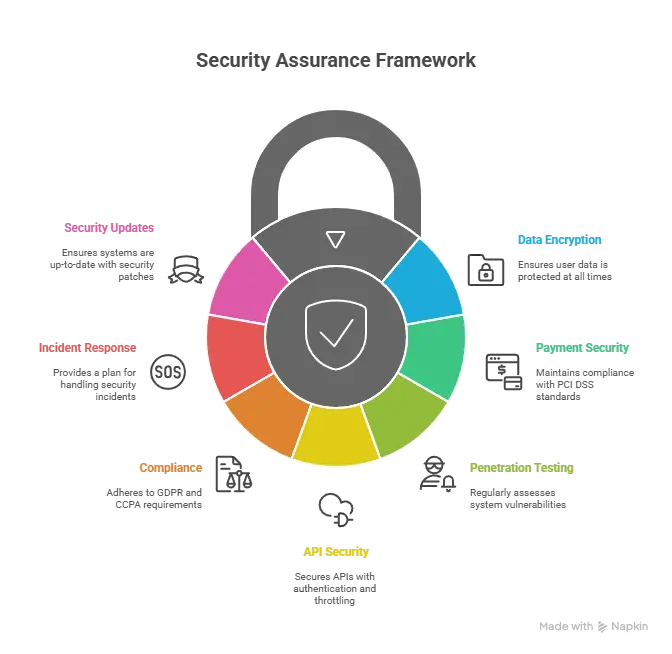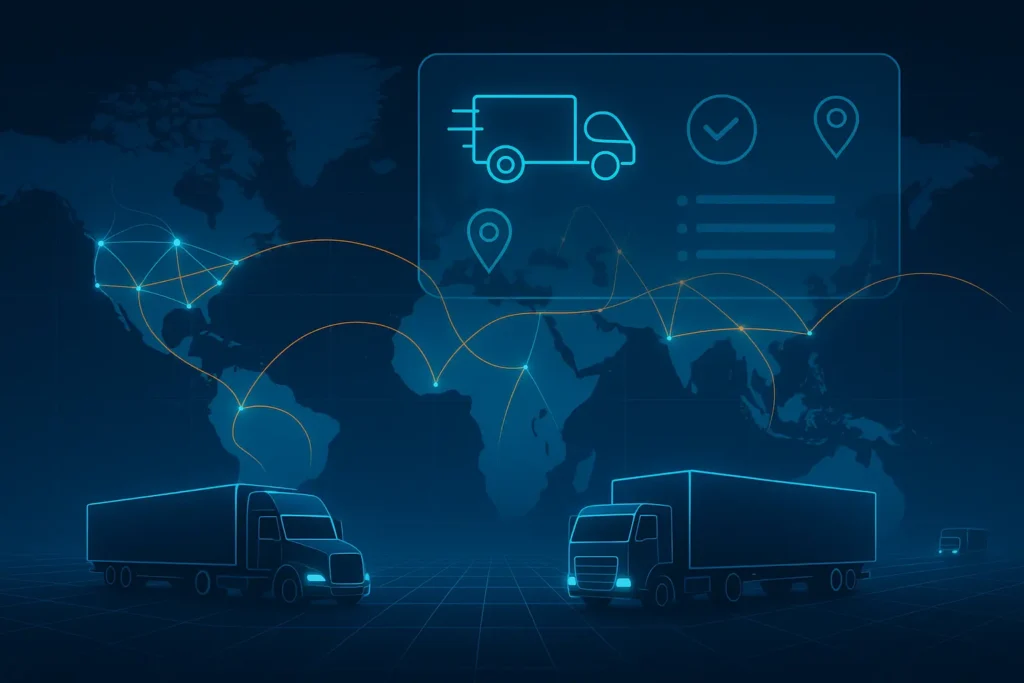You’ve heard the horror stories about ride-hailing apps being hacked, rider data stolen, or drivers falling victim to scams. In 2025, when mobility is powered by data-driven platforms, security isn’t optional—it’s survival.
For entrepreneurs and businesses considering a white-label Uber clone, safety concerns are often the biggest hesitation. With millions of daily transactions involving sensitive user data, payment credentials, and real-time location tracking, even a single breach can cause catastrophic damage to your brand.
In this guide, we’ll provide an honest assessment of White-label Uber app safety, break down the real risks, and share practical security steps you can take to protect your platform, your drivers, and your riders.
At the end, you’ll see why Miracuves’ security-first approach makes it the most trusted partner for launching safe and compliant ride-hailing apps.
Understanding White-Label Uber Security Landscape
What “White-Label Security” Actually Means
When businesses choose a white-label Uber app, they are essentially adopting a pre-built ride-hailing solution that can be customized with branding, features, and integrations. But security doesn’t automatically come with the “ready-made” package — it has to be built-in, tested, and constantly maintained. White-label security refers to how well the app framework protects data, transactions, and user interactions once it’s adapted to your business.

Common Security Myths vs. Reality
- Myth 1: White-label apps are less secure than custom-built apps.
Reality: Security depends on the provider’s practices, not the label. A well-audited white-label Uber app can be safer than a poorly coded custom build. - Myth 2: Compliance only matters in large markets.
Reality: Even small-scale operators must meet GDPR, CCPA, or regional data protection laws, or risk penalties. - Myth 3: Security is a one-time setup.
Reality: Threats evolve daily — ride-hailing apps need continuous monitoring, patches, and penetration testing.
Why People Worry About White-Label Uber Apps
- Sensitive rider data: names, phone numbers, addresses, and ride history.
- Financial transactions: credit card, wallet, or third-party payment systems.
- Location tracking: real-time GPS data of drivers and riders.
- Reputation risks: one breach can erode trust faster than marketing can build it.
Current Threat Landscape for Ride-Hailing Apps
In 2025, ride-hailing platforms face risks from multiple fronts:
- Data breaches targeting user profiles and payments.
- Fake driver/rider accounts exploiting weak verification processes.
- API abuse, where attackers manipulate booking, pricing, or identity systems.
- Ransomware attacks on backend servers controlling dispatch systems.
Security Standards in 2025
To combat these risks, global standards are evolving:
- Zero Trust Architecture is becoming the norm for app infrastructures.
- AI-driven fraud detection for suspicious logins and ride patterns.
- Mandatory data encryption for all personal and payment data.
- Regional compliance enforcement is stricter than ever (EU’s GDPR fines increased by 30% on average in 2024).
Real-World Statistics on App Security Incidents
- In 2024, 43% of ride-hailing data breaches were linked to weak API security.
- 62% of consumers reported they would delete an app permanently after one security incident.
- The average cost of a single mobility app data breach reached $4.9 million in 2024 (IBM Cost of a Data Breach Report).
Read more: – What is Rappi App and How Does It Work?
Key Security Risks & How to Identify Them
When considering a White-label Uber app, you need to recognize where the real risks lie. These can be broadly divided into data privacy, technical vulnerabilities, and business risks.
Data Protection & Privacy Risks
- User Personal Information
- Names, phone numbers, email addresses, and ride histories are prime targets for identity theft.
- Weak storage or poor encryption can expose sensitive records.
- Payment Data Security
- Credit card and wallet transactions are vulnerable without PCI DSS compliance.
- Insecure third-party payment gateways are common weak spots.
- Location Tracking Concerns
- Real-time GPS data can be exploited by hackers or malicious insiders.
- Geolocation leaks risk both safety and privacy violations.
- GDPR/CCPA Compliance
- Non-compliance with global privacy laws can result in multi-million-dollar fines.
- User consent management and right-to-delete processes must be properly implemented.
Technical Vulnerabilities
- Code Quality Issues
- Poorly written or outdated code can open doors to malware injections.
- Server Security Gaps
- Weak hosting environments can lead to DDoS attacks or system downtime.
- API Vulnerabilities
- Insecure APIs are a top threat, allowing attackers to manipulate bookings, fares, or user data.
- Third-Party Integrations
- Popular add-ons (maps, analytics, chat systems) may not be secured to the same standard as the app core.
Business Risks
- Legal Liability
- A breach could leave your company liable under data protection laws.
- Reputation Damage
- Customers often abandon apps permanently after a breach.
- Financial Losses
- Direct costs of breach response + indirect costs from lost customers.
- Regulatory Penalties
- Failure to meet standards (GDPR, PCI DSS) leads to fines and sometimes criminal action.

Read more: –What is Thumbtack App and How Does It Work?
Security Standards Your White-Label Uber App Must Meet
Security isn’t just about good coding practices; it’s about meeting global standards that prove your platform can handle sensitive data responsibly. In 2025, these certifications and technical safeguards are considered the baseline for any serious white-label Uber solution.
Essential Certifications
- ISO 27001 Compliance
Ensures your app provider follows strict information security management practices. - SOC 2 Type II
Validates that systems are designed to keep data secure over time, not just at a single point. - GDPR Compliance
Mandatory for businesses handling EU user data. Requires lawful data collection, storage, and deletion processes. - HIPAA (if applicable)
Essential only if your ride-hailing app processes health-related or medical transportation data. - PCI DSS
Required for handling and processing credit card transactions securely.
Technical Requirements
- End-to-End Encryption
Protects rider, driver, and payment data from interception. - Secure Authentication (2FA/OAuth)
Prevents unauthorized account access through stronger login systems. - Regular Security Audits
Independent third-party audits identify vulnerabilities before attackers do. - Penetration Testing
Simulates real-world attacks to validate defenses. - SSL Certificates
Mandatory for secure data transfer between app and servers. - Secure API Design
Ensures APIs cannot be easily exploited or abused.
Security Standards Comparison Table
| Security Requirement | Mandatory | Recommended | Notes |
|---|---|---|---|
| ISO 27001 | Yes | – | Global baseline certification |
| SOC 2 Type II | Yes | – | Validates long-term security controls |
| GDPR Compliance | Yes | – | Required for EU operations |
| HIPAA | Conditional | Yes | Only for healthcare-related use cases |
| PCI DSS | Yes | – | Required for payment security |
| End-to-End Encryption | Yes | – | Essential for all data |
| Secure Authentication | Yes | – | 2FA/OAuth strongly advised |
| Regular Security Audits | Yes | – | Independent verification |
| Penetration Testing | Yes | – | Should be ongoing |
| SSL Certificates | Yes | – | Baseline requirement |
| Secure API Design | Yes | – | Critical for ride-booking logic |
How to Spot Unsafe White-Label Providers
Not all white-label Uber providers are created equal. Many offer low-cost solutions that look attractive upfront but come with dangerous security gaps. Here’s how to identify unsafe vendors before committing.
Warning Signs
- No security documentation
If the provider can’t produce security policies or audit reports, that’s a red flag. - Cheap pricing without explanation
Security costs money. Extremely low pricing often means cutting corners on audits, encryption, or compliance. - No compliance certifications
Lack of ISO, SOC 2, or PCI DSS compliance means your business carries the full liability. - Outdated technology stack
Using old frameworks or unsupported software increases vulnerability to attacks. - Poor code quality
Sloppy coding practices leave exploitable loopholes in the system. - No security updates policy
If they don’t provide regular patches, your app becomes an easy target as threats evolve. - Lack of data backup systems
Without backup and recovery, a ransomware attack could take down your entire business. - No insurance coverage
A provider unwilling to back its security with liability insurance is shifting all risk to you.
Evaluation Checklist
To properly evaluate a white-label Uber provider, here are steps you should take:
- Questions to Ask Providers
- How often do you perform penetration tests?
- What compliance standards do you meet?
- What is your policy for security patches?
- Documents to Request
- ISO 27001 or SOC 2 certification reports
- PCI DSS compliance confirmation
- Security audit reports
- Testing Procedures
- Conduct your own penetration test or hire a third-party auditor before deployment.
- Due Diligence Steps
- Check references and past clients.
- Review their incident response plan.
- Ensure they provide data protection agreements in writing.
Read more : –What is Blinkit App and How Does It Work?
Best Practices for Secure White-Label Uber Implementation
A white-label Uber app can be secure — but only if you follow best practices before launch and after deployment. Security must be proactive, continuous, and verifiable.
Pre-Launch Security
- Security Audit Process
Conduct a full third-party security audit before going live to identify vulnerabilities in both code and infrastructure. - Code Review Requirements
Ensure the provider follows peer-reviewed coding practices and automated vulnerability scanning. - Infrastructure Hardening
Configure servers, firewalls, and databases to industry standards, reducing the attack surface. - Compliance Verification
Validate GDPR, PCI DSS, and other regulatory requirements through documentation and external audits. - Staff Training Programs
Train developers, admins, and support staff on secure coding, data handling, and incident response.
Post-Launch Monitoring
- Continuous Security Monitoring
Implement intrusion detection systems and real-time monitoring for suspicious activity. - Regular Updates and Patches
Keep your app updated with security fixes as new vulnerabilities emerge. - Incident Response Planning
Have a documented response process for breaches, including escalation protocols and customer communication. - User Data Management
Follow strict retention and deletion policies to minimize unnecessary data storage risks. - Backup and Recovery Systems
Automated daily backups with secure offsite storage ensure quick recovery after an attack.
Security Implementation Timeline
| Stage | Security Action | Responsibility |
|---|---|---|
| Development Phase | Secure coding, code reviews, API security | Provider + Client |
| Pre-Launch | Security audit, compliance verification, training | Client + Third-Party |
| Launch | Infrastructure hardening, backup setup | Provider |
| Post-Launch | Continuous monitoring, regular updates, testing | Provider + Client |
| Ongoing | Incident response, compliance renewal, audits | Client + Third-Party |
Legal & Compliance Considerations
Launching a white-label Uber app is not just about technology — it’s about navigating the legal and regulatory environment that governs data, payments, and user rights. Failure to comply doesn’t just risk fines; it can shut down your entire operation.
Regulatory Requirements
- Data Protection Laws by Region
- GDPR (EU): Requires explicit user consent, right-to-be-forgotten, and strict data handling policies.
- CCPA (California, US): Grants users rights over data access, deletion, and opt-out of data sales.
- PDPA (Singapore), LGPD (Brazil), IT Act (India): Regional equivalents with similar user data protections.
- Industry-Specific Regulations
- If your app expands into corporate mobility or healthcare transport, HIPAA or SOC compliance may apply.
- User Consent Management
- Consent banners, opt-in/opt-out controls, and accessible privacy dashboards must be built into the app.
- Privacy Policy Requirements
- Must clearly outline data collection, storage, and third-party sharing practices.
- Must be transparent and updated whenever practices change.
- Terms of Service Essentials
- Define liabilities, user responsibilities, and dispute resolution processes.
- Include clauses about data usage, cancellation policies, and compliance commitments.
Liability Protection
- Insurance Requirements
- Cyber liability insurance to cover data breaches and financial losses.
- Errors & Omissions (E&O) insurance to protect against lawsuits due to provider negligence.
- Legal Disclaimers
- Clearly state limitations of liability in cases of force majeure or third-party service failures.
- User Agreements
- Drivers and riders must acknowledge agreements outlining acceptable use and dispute resolution.
- Incident Reporting Protocols
- Define how breaches are reported to regulators (GDPR requires reporting within 72 hours).
- Regulatory Compliance Monitoring
- Regular internal audits and third-party reviews to ensure continuous adherence to laws.
Compliance Checklist by Region
| Region | Key Regulations | Required Actions |
|---|---|---|
| EU | GDPR | User consent mgmt, right-to-delete, encryption |
| US | CCPA, PCI DSS | Data transparency, payment security, opt-out options |
| Asia | PDPA (Singapore), IT Act (India) | Regional consent laws, breach reporting |
| Brazil | LGPD | Similar to GDPR, requires lawful basis for data use |
| Global | ISO 27001, SOC 2 | Security certifications for international trust |
Why Miracuves White-Label Uber is Your Safest Choice
When it comes to ride-hailing, security is not a feature — it’s the foundation. At Miracuves, we’ve designed our white-label Uber solutions with enterprise-grade security at every layer.
Miracuves Security Advantages
- Enterprise-Grade Security Architecture
Built on secure frameworks with layered defenses, ensuring both scalability and protection. - Regular Security Audits and Certifications
Independent audits and penetration tests keep vulnerabilities in check. - GDPR/CCPA Compliant by Default
Our platforms are designed to meet global privacy laws out of the box. - 24/7 Security Monitoring
Real-time systems detect suspicious activities before they escalate. - Encrypted Data Transmission
All user, driver, and payment data is encrypted end-to-end. - Secure Payment Processing
PCI DSS-certified gateways safeguard transactions. - Regular Security Updates
Continuous patches ensure your platform is always protected against new threats. - Insurance Coverage Included
Added peace of mind with liability protection built into our offerings.
Conclusion:
Don’t compromise on security. Miracuves white-label Uber solutions come with enterprise-grade security built in. Our 600+ successful projects have maintained zero major security breaches, proving our commitment to safe, compliant platforms.
At Miracuves, we believe that security is the ultimate competitive advantage. By prioritizing protection from day one, you not only safeguard your riders and drivers but also build a brand that users can trust long-term.
If you’re serious about launching a white-label Uber app, make security your starting point — and let Miracuves be the partner that helps you scale safely.
FAQs
How secure is white-label vs custom development?
A well-built white-label Uber app can be just as secure, if not more secure, than a custom solution. The key difference lies in whether the provider follows strict compliance and testing standards.
What happens if there’s a security breach?
A breach triggers your incident response plan: containment, notification to regulators (within 72 hours under GDPR), customer communication, and remediation. With Miracuves, continuous monitoring and backups reduce downtime.
Who is responsible for security updates?
The provider must deliver regular security patches and compliance updates. At Miracuves, these are included in your service plan.
How is user data protected in white-label apps?
Through end-to-end encryption, secure servers, GDPR-compliant consent flows, and strong authentication protocols.
What compliance certifications should I look for?
At minimum: ISO 27001, SOC 2 Type II, PCI DSS, and GDPR compliance. Healthcare-related apps may also require HIPAA.
Can white-label apps meet enterprise security standards?
Yes. With proper certifications, audits, and continuous monitoring, white-label Uber solutions can meet enterprise-grade requirements.
How often should security audits be conducted?
Best practice is annual third-party audits, supplemented by quarterly penetration testing.
What’s included in Miracuves security package?
Regular audits and penetration tests
Encrypted data storage and transfer
PCI DSS-certified payment systems
24/7 monitoring
GDPR/CCPA compliance by default
Insurance-backed coverage
How to handle security in different countries?
Security must align with local data protection laws (GDPR in Europe, CCPA in California, LGPD in Brazil, PDPA in Singapore, IT Act in India). Miracuves platforms are adaptable to regional compliance.
What insurance is needed for app security?
Cyber liability insurance and Errors & Omissions (E&O) insurance are critical. Miracuves offers insurance-backed solutions to reduce client risk exposure.








